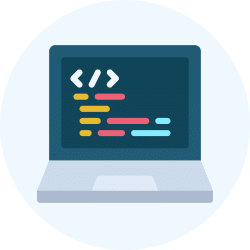Assignment: Malware Threats | Ethical Hacking using Kali Linux (in English) - Software Development PDF Download
| Table of contents |

|
| Multiple Choice Questions (MCQs) |

|
| Fill in the Blanks |

|
| True/False |

|
| HOTS (Higher Order Thinking Skills) Questions |

|
| Hands-on Coding Questions |

|
Multiple Choice Questions (MCQs)
Q1: What is the primary function of a Trojan horse in cybersecurity?
(a) Encrypt user data for ransom
(b) Appear as a legitimate program while performing malicious actions
(c) Spread automatically without user interaction
(d) Record keystrokes and steal credentials
Ans: (b) Appear as a legitimate program while performing malicious actions
Q2: Which of the following is an example of ransomware?
(a) WannaCry
(b) Stuxnet
(c) SQL Slammer
(d) Netbus
Ans: (a) WannaCry
Q3: What does a keylogger do?
(a) Encrypts files on a victim’s computer
(b) Records keystrokes to steal sensitive information
(c) Hides files from the user
(d) Spreads via network shares
Ans: (b) Records keystrokes to steal sensitive information
Q4: Which command is used in Linux to check running processes for malware?
(a) top
(b) ps aux
(c) ls -l
(d) df -h
Ans: (b) ps aux
Q5: Which type of malware spreads without user interaction?
(a) Virus
(b) Worm
(c) Trojan
(d) Rootkit
Ans: (b) Worm
Q6: What is a common persistence technique used by malware?
(a) Creating a registry entry
(b) Running as a guest user
(c) Using the cd command
(d) Disabling firewalls
Ans: (a) Creating a registry entry
Q7: What is the purpose of a rootkit?
(a) Encrypt user files
(b) Provide unauthorized access while remaining hidden
(c) Display fake antivirus alerts
(d) Log out users from the system
Ans: (b) Provide unauthorized access while remaining hidden
Q8: What command is used to scan for malware in a Linux system?
(a) chkrootkit
(b) netstat
(c) whoami
(d) cat /etc/passwd
Ans: (a) chkrootkit
Q9: What technique do attackers use to distribute malware via email?
(a) Phishing
(b) Port scanning
(c) DNS spoofing
(d) Keylogging
Ans: (a) Phishing
Q10: Which tool is commonly used for malware analysis?
(a) Wireshark
(b) Metasploit
(c) Volatility
(d) Aircrack-ng
Ans: (c) Volatility
Fill in the Blanks
Q1: A ________ disguises itself as legitimate software while performing malicious actions.
Ans: Trojan horse
Q2: ________ is a type of malware that demands payment to restore access to files.
Ans: Ransomware
Q3: Attackers use ________ to send deceptive emails that trick users into downloading malware.
Ans: Phishing
Q4: ________ is a command-line tool used to detect rootkits on Linux systems.
Ans: chkrootkit
Q5: ________ is a memory forensics tool used for analyzing malware in RAM.
Ans: Volatility
True/False
1. Worms require user interaction to spread.
Ans: False
2. Keyloggers can be both hardware and software-based.
Ans: True
3. A rootkit hides itself and other malicious activities on a system.
Ans: True
4. Ransomware typically spreads through brute-force attacks.
Ans: False
5. Antivirus software can always detect zero-day malware.
Ans: False
HOTS (Higher Order Thinking Skills) Questions
Q1: Your company’s network has been infected with ransomware. What immediate steps would you take to minimize damage?
Ans: Disconnect affected systems, identify the ransomware type, restore from backups, report the attack, and update security policies.
Q2: A user reports suspicious activity on their machine. You suspect a Trojan is running in the background. How would you verify and remove it?
Ans: Use ps aux (Linux) or tasklist (Windows) to check running processes, scan with chkrootkit or an antivirus, and remove malicious entries from startup.
Q3: You need to analyze a suspected malware file. What steps would you take in a controlled environment?
Ans: Use a virtual machine, analyze with Volatility, inspect network traffic with Wireshark, and decompile the malware if necessary.
Q4: An employee unknowingly clicked on a phishing email attachment. What security measures should be in place to prevent such incidents?
Ans: Implement email filtering, conduct cybersecurity training, enable multi-factor authentication, and use endpoint protection tools.
Q5: A Linux server is behaving suspiciously, and you suspect it has been compromised by a rootkit. How would you investigate?
Ans: Run chkrootkit or rkhunter, check for hidden processes (lsmod, ps aux), and inspect network activity (netstat -an).
Hands-on Coding Questions
Q1: Write a Python script to detect running processes and check for suspicious ones.
Ans:
import psutil
suspicious_processes = ["nc", "netcat", "meterpreter", "keylogger"]
for process in psutil.process_iter(['pid', 'name']):
if process.info['name'] in suspicious_processes:
print(f"Suspicious process detected: {process.info['name']} (PID: {process.info['pid']})")
Q2: Create a Bash script that scans for rootkits using chkrootkit and outputs the results to a log file.
Ans:
#!/bin/bash
echo "Running chkrootkit scan..." > malware_scan.log
chkrootkit >> malware_scan.log
echo "Scan complete. Check malware_scan.log for details."
|
120 videos|6 docs
|
FAQs on Assignment: Malware Threats - Ethical Hacking using Kali Linux (in English) - Software Development
| 1. What are the common types of malware threats that software developers should be aware of? |  |
| 2. How can software developers protect their applications from malware threats? |  |
| 3. What is the impact of ransomware on software development and businesses? |  |
| 4. Why is it important for software developers to stay updated on malware threats? |  |
| 5. What role do user education and awareness play in mitigating malware threats? |  |















